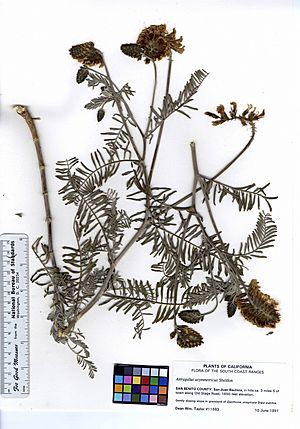San Joaquin milkvetch facts for kids
Quick facts for kids San Joaquin milkvetch |
|
|---|---|
 |
|
| Scientific classification | |
| Genus: |
Astragalus
|
| Species: |
asymmetricus
|
The San Joaquin milkvetch (scientific name: Astragalus asymmetricus) is a special type of plant called a milkvetch. It is found only in California, which means it is endemic to that state. You can often find it growing in grassy areas and places where the ground has been disturbed, like along roadsides. It lives mostly in California's Central Valley, but also in nearby parts of the Central Coast Ranges and the San Francisco Bay Area.
Meet the San Joaquin Milkvetch
The San Joaquin milkvetch is a strong plant that lives for many years. It grows a thick, straight stem that can reach between 50 and 120 cm (20 and 47 in) (about 1.5 to 4 feet) tall. The whole plant is covered in long, soft hairs.
Its leaves can be up to 20 cm (7.9 in) (about 8 inches) long. Each leaf is made up of many smaller leaflets, which are like tiny leaves themselves. These leaflets grow in pairs and can be up to 2.5 cm (0.98 in) (about 1 inch) long. They can be shaped like long, thin lines or more like ovals.
Flowers and Fruits
The plant produces groups of flowers called an inflorescence. Each group holds about 15 to 45 cream-colored flowers. These flowers look a bit like peas and are about 1 to 2 cm (0.39 to 0.79 in) (0.4 to 0.8 inches) long.
After the flowers bloom, they turn into fruits. These fruits are slightly puffed-up, hairy pods called legumes. Each pod can be up to 4 cm (1.6 in) (about 1.5 inches) long. They hang in bunches from the plant after the flowers have dried up.
See also
 In Spanish: Astragalus asymmetricus para niños
In Spanish: Astragalus asymmetricus para niños

